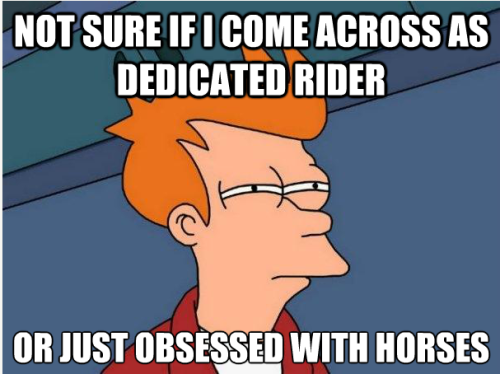Hello Bloglings,
Greetings from Minnesota! As I drove to work this morning my outside temperature indicated it was -4 degrees, and the snow squeaks under my tires - it is COLD!
This winter, with Foxie seeming like she isn't running quite as warm as she used too, and the skinny 4-year old not growing in the coat I was expecting, I have been blanketing off of the horse.com guide:
50-60 degrees - sheet
40-50 degrees - Light blanket
30-40 degrees - Light/Medium blanket
20-30 degrees - Medium/Heavy blanket
Below 20 - Heavy blanket
Bailey has a fresh modified Irish clip as of a few days ago, and Foxie is being left in her full hairy glory, as she really doesn't work hard enough to warrant a clip. I am growing quite fond of my new Schneider's blanket liners, which I loved the idea of and have found that they proved themselves thus far 110%. As I've probably said several times on this blog, I HATE fleece as a blanket liner. It gets static-y and I have found that most of the liners I've seen tend to slip, rub or stretch, making them an investment that doesn't last long. The Schneider's blanket liners are ultra light weight and offer a nice slick nylon outside that doesn't rub the coat or cause static thus far. The liners stay in place with the leg straps of the outside blanket and actually STAY in place, which is amazing. They are 150g of warmth and so far have been used under rain sheets for chilly days and Bailey is wearing one under her Medium blanket from Schneider's to push it up to a heavy for this freezing weather.
Speaking of Bailey's medium...

You can find the review below this post right here on this blog!
Right now, Bailey has the following blankets:
Weatherbeeta Genero 1200D T/O Sheet
Weatherbeeta 1200D Original Detatch-A-Neck Medium
Schneiders 1680D Attached Neck Arctic Combo (Medium)
Schneiders Blanket Liner (180 grams)
Right now she's wearing the liner and the Arctic Combo, for a total of 400 grams, the warmest option she can be wearing. So far, I'm quite pleased with the current lineup -a less heavy neck for days above 20 or so, a heavier one for the really cold days and the option of a regular, neck-less medium should I want it. I feel that the Arctic Combo, with it's lined neck, is much warmer than the standard medium and functions as a heavier-than-medium blanket that can be used before we get to the blanket + liner stage. Perhaps I'm a madwoman. Perhaps I should just buy a blanket in the proper weight. But I'm pretty darn satisfied with this selection, which is all that matters.
I also am pleased to have two "extras" for just in case type days - a rain sheet and a medium, and part time, the infamous 80 gram enigma blanket. I really like the idea of the 80 gram but haven't quite found a replacement that I'm truly happy with (it's been with Foxie almost as long as I've owned her and is really sun faded / not very waterproof, also the fate of the medium mentioned above) so it will stay around as an under blanket or no-rain blanket until I find something that works.
In an attempt to reel you readers in, how do you blanket? What weights of blanket do you keep "on tap" for your corner of the world?
Kicking On,
Ashley, Foxie and Bailey
Greetings from Minnesota! As I drove to work this morning my outside temperature indicated it was -4 degrees, and the snow squeaks under my tires - it is COLD!
This winter, with Foxie seeming like she isn't running quite as warm as she used too, and the skinny 4-year old not growing in the coat I was expecting, I have been blanketing off of the horse.com guide:
50-60 degrees - sheet
40-50 degrees - Light blanket
30-40 degrees - Light/Medium blanket
20-30 degrees - Medium/Heavy blanket
Below 20 - Heavy blanket
Bailey has a fresh modified Irish clip as of a few days ago, and Foxie is being left in her full hairy glory, as she really doesn't work hard enough to warrant a clip. I am growing quite fond of my new Schneider's blanket liners, which I loved the idea of and have found that they proved themselves thus far 110%. As I've probably said several times on this blog, I HATE fleece as a blanket liner. It gets static-y and I have found that most of the liners I've seen tend to slip, rub or stretch, making them an investment that doesn't last long. The Schneider's blanket liners are ultra light weight and offer a nice slick nylon outside that doesn't rub the coat or cause static thus far. The liners stay in place with the leg straps of the outside blanket and actually STAY in place, which is amazing. They are 150g of warmth and so far have been used under rain sheets for chilly days and Bailey is wearing one under her Medium blanket from Schneider's to push it up to a heavy for this freezing weather.
Speaking of Bailey's medium...

You can find the review below this post right here on this blog!
Right now, Bailey has the following blankets:
Weatherbeeta Genero 1200D T/O Sheet
Weatherbeeta 1200D Original Detatch-A-Neck Medium
Schneiders 1680D Attached Neck Arctic Combo (Medium)
Schneiders Blanket Liner (180 grams)
Right now she's wearing the liner and the Arctic Combo, for a total of 400 grams, the warmest option she can be wearing. So far, I'm quite pleased with the current lineup -a less heavy neck for days above 20 or so, a heavier one for the really cold days and the option of a regular, neck-less medium should I want it. I feel that the Arctic Combo, with it's lined neck, is much warmer than the standard medium and functions as a heavier-than-medium blanket that can be used before we get to the blanket + liner stage. Perhaps I'm a madwoman. Perhaps I should just buy a blanket in the proper weight. But I'm pretty darn satisfied with this selection, which is all that matters.
I also am pleased to have two "extras" for just in case type days - a rain sheet and a medium, and part time, the infamous 80 gram enigma blanket. I really like the idea of the 80 gram but haven't quite found a replacement that I'm truly happy with (it's been with Foxie almost as long as I've owned her and is really sun faded / not very waterproof, also the fate of the medium mentioned above) so it will stay around as an under blanket or no-rain blanket until I find something that works.
In an attempt to reel you readers in, how do you blanket? What weights of blanket do you keep "on tap" for your corner of the world?
Kicking On,
Ashley, Foxie and Bailey


























